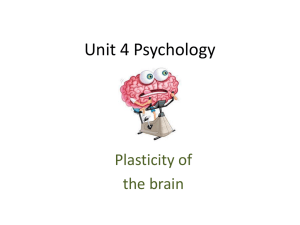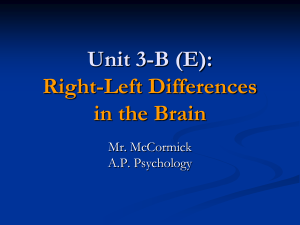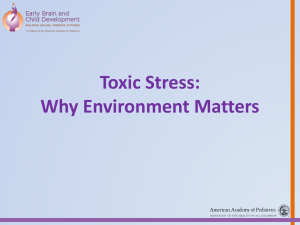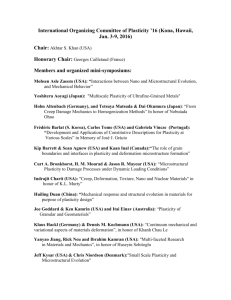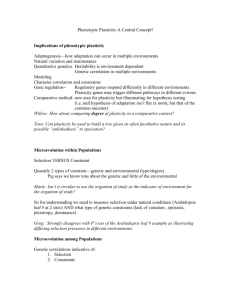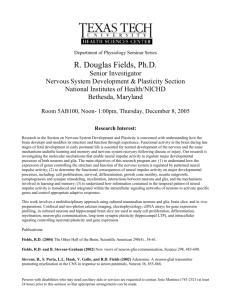New Advances in Understanding Sensitive Periods in Brain
advertisement
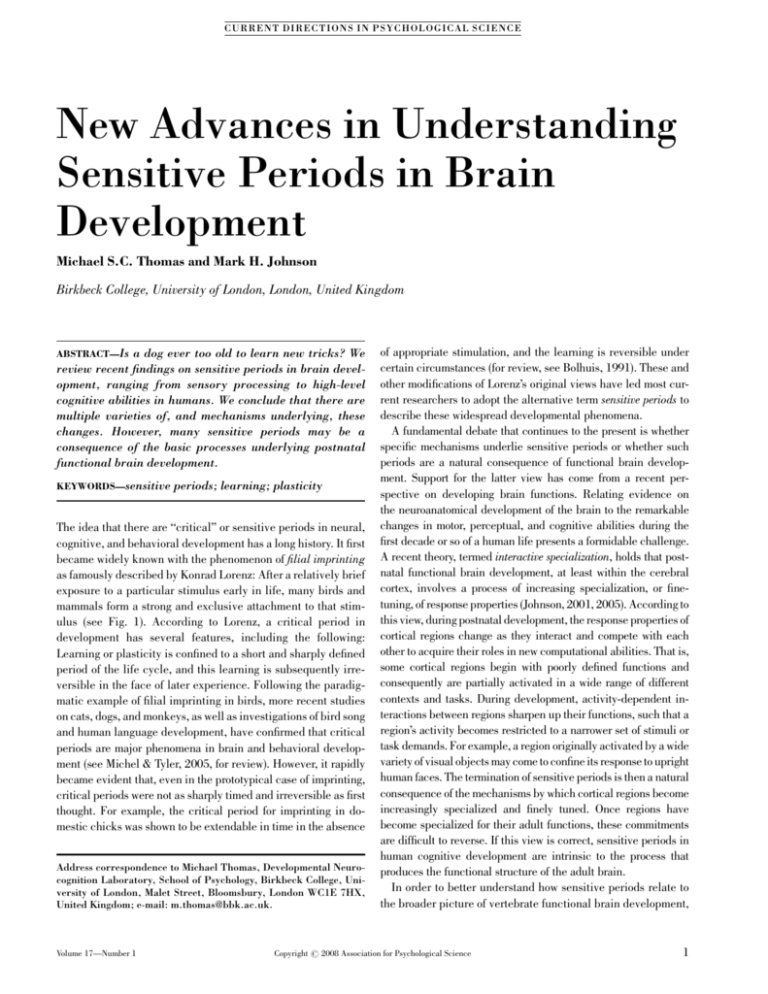
CU R RE N T D I R E CT I O NS IN P SYC H OL OGI C AL SC I EN C E New Advances in Understanding Sensitive Periods in Brain Development Michael S.C. Thomas and Mark H. Johnson Birkbeck College, University of London, London, United Kingdom ABSTRACT—Is a dog ever too old to learn new tricks? We review recent findings on sensitive periods in brain development, ranging from sensory processing to high-level cognitive abilities in humans. We conclude that there are multiple varieties of, and mechanisms underlying, these changes. However, many sensitive periods may be a consequence of the basic processes underlying postnatal functional brain development. KEYWORDS—sensitive periods; learning; plasticity The idea that there are ‘‘critical’’ or sensitive periods in neural, cognitive, and behavioral development has a long history. It first became widely known with the phenomenon of filial imprinting as famously described by Konrad Lorenz: After a relatively brief exposure to a particular stimulus early in life, many birds and mammals form a strong and exclusive attachment to that stimulus (see Fig. 1). According to Lorenz, a critical period in development has several features, including the following: Learning or plasticity is confined to a short and sharply defined period of the life cycle, and this learning is subsequently irreversible in the face of later experience. Following the paradigmatic example of filial imprinting in birds, more recent studies on cats, dogs, and monkeys, as well as investigations of bird song and human language development, have confirmed that critical periods are major phenomena in brain and behavioral development (see Michel & Tyler, 2005, for review). However, it rapidly became evident that, even in the prototypical case of imprinting, critical periods were not as sharply timed and irreversible as first thought. For example, the critical period for imprinting in domestic chicks was shown to be extendable in time in the absence Address correspondence to Michael Thomas, Developmental Neurocognition Laboratory, School of Psychology, Birkbeck College, University of London, Malet Street, Bloomsbury, London WC1E 7HX, United Kingdom; e-mail: m.thomas@bbk.ac.uk. Volume 17—Number 1 of appropriate stimulation, and the learning is reversible under certain circumstances (for review, see Bolhuis, 1991). These and other modifications of Lorenz’s original views have led most current researchers to adopt the alternative term sensitive periods to describe these widespread developmental phenomena. A fundamental debate that continues to the present is whether specific mechanisms underlie sensitive periods or whether such periods are a natural consequence of functional brain development. Support for the latter view has come from a recent perspective on developing brain functions. Relating evidence on the neuroanatomical development of the brain to the remarkable changes in motor, perceptual, and cognitive abilities during the first decade or so of a human life presents a formidable challenge. A recent theory, termed interactive specialization, holds that postnatal functional brain development, at least within the cerebral cortex, involves a process of increasing specialization, or finetuning, of response properties (Johnson, 2001, 2005). According to this view, during postnatal development, the response properties of cortical regions change as they interact and compete with each other to acquire their roles in new computational abilities. That is, some cortical regions begin with poorly defined functions and consequently are partially activated in a wide range of different contexts and tasks. During development, activity-dependent interactions between regions sharpen up their functions, such that a region’s activity becomes restricted to a narrower set of stimuli or task demands. For example, a region originally activated by a wide variety of visual objects may come to confine its response to upright human faces. The termination of sensitive periods is then a natural consequence of the mechanisms by which cortical regions become increasingly specialized and finely tuned. Once regions have become specialized for their adult functions, these commitments are difficult to reverse. If this view is correct, sensitive periods in human cognitive development are intrinsic to the process that produces the functional structure of the adult brain. In order to better understand how sensitive periods relate to the broader picture of vertebrate functional brain development, Copyright r 2008 Association for Psychological Science 1 Sensitive Periods in Brain Development components. The literature currently available suggests that plasticity tends to reduce in low-level sensory systems before it reduces in high-level cognitive systems (Huttenlocher, 2002). While it is now agreed that there are multiple sensitive periods even within one sensory modality in a given species, there is still considerable debate as to whether these different sensitive periods reflect common underlying mechanisms or whether different mechanisms and principles operate in each case. MECHANISMS UNDERLYING SENSITIVE PERIODS Fig. 1. Examples of stimuli used to study visual imprinting in the domestic chick. Chicks are hatched and reared in darkness before being exposed to a visual stimulus. Training usually lasts for a period of several hours. Hours or days later, the chick is released in the presence of two objects: one to which it was exposed earlier and a novel object. If the chick has imprinted strongly, it will show a high preference for the familiar object by approaching it. researchers have addressed a number of specific questions. In any given species are there multiple sensitive periods or just a few (e.g., one per sensory modality)? If there are multiple sensitive periods, do they share common underlying mechanisms? What are the processes that underlie the end of sensitive periods and the corresponding reduction in plasticity? VARIETIES OF SENSITIVE PERIOD Recent work indicates that there are multiple sensitive periods in the sensory systems that have been studied. For example, within the auditory domain in humans, there are different sensitive periods for different facets of speech processing and other sensitive periods, having different timing, related to basic aspects of music perception. Similarly, in nonhuman-primate visual systems there are, at a minimum, different sensitive periods related to amblyopia (a condition found in early childhood in which one eye develops good vision but the other does not), visual acuity, motion perception, and face processing (see Johnson, 2005, for review). How these different and varied sensitive periods relate to each other is still poorly understood. But high-level skills like human language involve the integration of many lower-level systems, and plasticity in language acquisition is therefore likely to be the combinatorial result of the relative plasticity of underlying auditory, phonological, semantic, syntactic, and motor systems, along with the developmental interactions among these 2 A major feature of sensitive periods is that plasticity appears to be markedly reduced at the end of the period. There are three general classes of explanation for this: (a) termination of plasticity due to maturation, (b) self-termination of learning, and (c) stabilization of constraints on plasticity (without a reduction in the underlying level of plasticity). According to the first view, endogenous changes in the neurochemistry of the brain region in question could increase the rate of pruning of synapses, resulting in the ‘‘fossilization’’ of existing patterns of functional connectivity. Thus, the termination of sensitive periods would be due to endogenous factors, would have a fixed time course, and could be specific to individual regions of the cortex. Empirical evidence on neurochemical changes associated with plasticity (such as expression of glutamatergic and GABA receptors in the human visual cortex) indicate that the periods of neurochemical change can occur around the age of functional sensitive periods (see Fig. 2). However, this does not rule out the possibility that these neurochemical changes are a consequence of the differences in functional activity due to termination of plasticity for some other reason, rather than its primary cause (Murphy, Betson, Boley, & Jones, 2005). The second class of mechanism implies that sensitive periods involve self-terminating learning processes. By this, we mean that the process of learning itself could produce changes that reduce the system’s plasticity. These types of mechanisms are most consistent with the view of sensitive periods as a natural consequence of typical functional brain development. An important way to describe and understand self-terminating learning comes from the use of computer-simulated neural networks (Thomas & Johnson, 2006). These models demonstrate mechanistically how processes of learning can lead to neurobiological changes that reduce plasticity, rather than plasticity changing according to a purely maturational timetable. Such computer models have revealed that, even where a reduction in plasticity emerges with increasing experience, a range of different specific mechanisms may be responsible for this reduction (see Thomas & Johnson, 2006). For example, it may be that the neural system’s computational resources, which are critical for future learning, have been claimed or used up by existing learning, so Volume 17—Number 1 Michael S.C. Thomas and Mark H. Johnson 70 Birth Synapses per 100 µm 60 Auditory cortex Visual cortex Prefrontal cortex 50 40 30 20 Adolescence 10 0 0 1000 2000 3000 4000 5000 6000 7000 8000 9000 10000 Age in days from conception Fig. 2. Synaptic density in different brain areas across the lifespan. Synapses, the structures through which neurons communicate, are initially overproduced in the brain, and the environment selects which ones are retained to support function. The density of synapses may be viewed as one measure of the plasticity of the system—the potential to alter connection strengths to reflect experience (Huttenlocher, 2002). Measures of synaptic density indicate that (a) there is a strong initial increase, which later subsides during mid-childhood and adolescence, and (b) the synapticdensity function peaks at different times in different regions of the brain. Notably, the prefrontal cortex (middle frontal gyrus), a region associated with higher-level cognition, shows the latest peak in synaptic density. (Data from Huttenlocher & Dabholkar, 1997). that any new learning must compete to capture these resources. Unless earlier-learned abilities are neglected or lost, new learning may always be limited by this competition. Another mechanism discovered through modeling is called entrenchment. In this case, prior experience places the system into a state that is nonoptimal for learning the new skill. It takes time to reconfigure the system for the new task and learning correspondingly takes longer than it would have done had the system been in an uncommitted state. A third mechanism is assimilation, whereby initial learning reduces the system’s ability to detect changes in the environment that might trigger further learning. Evidence from humans relevant to self-terminating sensitive periods is reported by Lewis and Maurer (2005), who have studied the outcome of cases of human infants born with dense bilateral cataracts in both eyes. Such dense bilateral cataracts restrict these infants to near blindness, but fortunately the condition can be rectified with surgery. Despite variation in the age of treatment from 1 to 9 months, infants were found to have the visual acuity of a newborn immediately following surgery to remove the cataracts. However, after only 1 hour of patterned vision, acuity had improved to the level of a typical 6-week-old; and after a further month of visual experience, the gap to age-matched controls was very considerably reduced. These findings correspond well with experiments showing that rearing animals in the dark appears to delay the end of the normal sensitive period. Thus, in at least some cases, plasticity seems to wait for the appropriate type of sensory stimulation. This is consistent with the idea that changes in plasticity can be driven by the learning processes associated with typical development. Volume 17—Number 1 Returning to the paradigmatic example of filial imprinting in birds, O’Reilly and Johnson (1994) constructed a computer model of the neural network known to support imprinting in the relevant region of the chick brain. This computer model successfully simulated a range of phenomena associated with imprinting behavior in the chick. Importantly, in both the model and the chick, the extent to which an imprinted preference for one object can be ‘‘reversed’’ by exposure to a second object depends on a combination of the length of exposure to the first object and the length of exposure to the second object (for review, see Bolhuis, 1991). In other words, in the model, the sensitive period was dependent on the respective levels of learning and was self-terminating. Additionally, like the chick, the network generalised from a training object to one that shared some of its features such as color or shape. By gradually changing the features of the object to which the chick was exposed, the chick’s preference could be shifted even after the ‘‘sensitive period’’ had supposedly closed. The simulation work demonstrated the sufficiency of simple learning mechanisms to explain the observed behavioral data (McClelland, 2005). The third class of explanation for the end of sensitive periods is that it represents the onset of stability in constraining factors rather than a reduction in the underlying plasticity. For example, while an infant is growing, the distance between her eyes increases, thereby creating instability in the information to visual cortical areas. However, once the inter-eye distance is fixed in development, the visual input becomes stable. Thus, brain plasticity may be ‘‘hidden’’ until it is revealed by some perturbation to another constraining factor that disrupts vision. 3 Sensitive Periods in Brain Development This mechanism offers an attractive explanation of the surprising degree of plasticity sometimes observed in adults, for instance after even brief visual deprivation. Sathian (2005) reported activity in the visual cortex during tactile perception in sighted human adults after brief visual deprivation—activity similar to that observed in those who have suffered long-term visual deprivation. While this line of research initially appears consistent with life-long plasticity, it is important to note that this tactile-induced visual-cortex activity is much greater if vision is lost early in life or was never present. Thus, although there appears to be residual connectivity between sensory systems that can be uncovered by blocking vision in sighted people, there is also a sensitive period during which these connections can be more drastically altered. SENSITIVE PERIODS IN SECOND LANGUAGE ACQUISITION Given the variety of mechanisms that may underlie sensitive periods, it would be interesting to know how such periods affect the acquisition of higher cognitive abilities in humans. Recent research on learning a second language illustrates one attempt to answer this question. If you want to master a second language, how important is the age at which you start to learn it? If you start to learn a second language as an adult, does your brain process it in a different way from how it processes your first language? It is often claimed that unless individuals acquire a second language (L2) before mid-childhood (or perhaps before puberty), then they will never reach native-like levels of proficiency in the second language in pronunciation or grammatical knowledge. This claim is supported by deprivation studies showing that the acquisition of a first language (L1) is itself less successful when begun after a certain age. Further, functional brain-imaging studies initially indicated that in L2 acquisition, different areas of the cortex were activated by the L2 than by the L1; only in individuals who had acquired two languages simultaneously were common areas activated (e.g., Kim, Relkin, Lee, & Hirsch, 1997). However, subsequent research has painted a more complex picture. First, claims for sensitive periods have tended to rely on assessing final level of attainment rather than speed of learning. This is because there is evidence that adults can learn a second language more quickly than children can, even if their final level of attainment is not as high. Indeed adults and children appear to learn a new language in different ways. Children are relatively insensitive to feedback and extract regularities from exposure to large amounts of input, whereas adults adopt explicit strategies and remain responsive to feedback (see, e.g., Hudson Kam & Newport, 2005). Second, even when the final level of L2 attainment is considered, it has proved hard to find an age after which prospective attainment levels off. That is, there is no strong evidence for a point at which a sensitive period completely closes (see, e.g., 4 Birdsong, 2006). Instead, L2 attainment shows a linear decline with age: The later you start, the lower your final level is likely to be (Birdsong, 2006). Third, recent functional imaging research has indicated that at least three factors are important in determining the relative brain-activation patterns produced by L1 and L2 during comprehension and production. These are the age of acquisition, the level of usage/exposure to each language, and the level of proficiency attained in L2. Overall, three broad themes have emerged (Abutalebi, Cappa, & Perani, 2005; Stowe & Sabourin, 2005): (a) The same network of left-hemisphere brain regions is involved in processing both languages; (b) a weak L2 is associated with more widespread neural activity compared to L1 in production (perhaps because the L2 is more effortful to produce) but less activation in comprehension (perhaps because the L2 is less well understood); and (c) the level of proficiency in L2 is more important than age of acquisition in determining whether L1 and L2 activate common or separate areas. In brief, the better you are at your L2, the more similar the activated regions become to those activated by your L1. This finding fits with the idea that certain brain areas have become optimized for processing language (perhaps during the acquisition of L1) and that, in order to become very good at L2, you have to engage these brain areas. The idea that later plasticity is tempered by the processing structures created by earlier learning fits with the interactivespecialization explanation for the closing of sensitive periods. Finally, in line with idea that language requires integration across multiple subskills, increasing evidence indicates that sensitive periods differ across the components of language (Neville, 2006; Wartenburger et al., 2003; Werker & Tees, 2005). Plasticity may show greater or earlier reductions for phonology and morphosyntax than it does for lexical-semantics, in which there may indeed be no age-related change at all. In other words, for the late language learner, new vocabulary is easier to acquire than new sounds or new grammar. CONCLUSION It is important to understand the mechanisms underlying sensitive periods for practical reasons. Age-of-acquisition effects may shape educational policy and the time at which children are exposed to different skills. The reversibility of effects of deprivation on development has important implications for interventions for children with congenital sensory impairments or children exposed to impoverished physical and social environments. And there are clinical implications for understanding the mechanisms that drive recovery from brain damage at different ages. Exciting vistas for the future include the possibility of using genetic and brain-imaging data to identify the best developmental times for training new skills in individual children, and the possibility that a deeper understanding of the neurocomputational principles that underlie self-terminating plasticity Volume 17—Number 1 Michael S.C. Thomas and Mark H. Johnson will allow the design of more efficient training procedures (McClelland 2005). Recommended Reading Birdsong, D. (2006). (See References). Discusses recent research on sensitive periods and second-language acquisition. Huttenlocher, P.R. (2002). (See References). An overview of neural plasticity. Johnson, M.H. (2005). Developmental cognitive neuroscience (2nd ed.). Oxford, UK: Blackwell. An introduction to the relationship between brain development and cognitive development. Knusden, E.I. (2004). Sensitive periods in the development of brain and behavior. Journal of Cognitive Neuroscience, 16, 1412–1425. A discussion of mechanisms of plasticity and sensitive periods at the level of neural circuits. Acknowledgments—This research was supported by Medical Research Council (MRC) Career Establishment Grant G0300188 to Michael Thomas, and MRC Grant G9715587 to Mark Johnson. REFERENCES Abutalebi, J., Cappa, S.F., & Perani, D. (2005). What can functional neuroimaging tell us about the bilingual brain? In J.F. Kroll & A.M.B. de Groot (Eds.), Handbook of bilingualism (p. 497–515). Oxford, UK: Oxford University Press. Birdsong, D. (2006). Age and second language acquisition and processing: A selective overview. Language Learning, 56, 9–49. Bolhuis, J.J. (1991). Mechanisms of avian imprinting: A review. Biological Reviews, 66, 303–345. Hudson Kam, C.L., & Newport, E.L. (2005). Regularizing unpredictable variation: The roles of adult and child learners in language formation and change. Language Learning and Development, 1, 151–195. Huttenlocher, P.R. (2002). Neural plasticity: The effects of the environment on the development of the cerebral cortex. Cambridge, MA: Harvard University Press. Huttenlocher, P.R., & Dabholkar, A.S. (1997). Regional differences in synaptogenesis in human cerebral cortex. Journal of Comparative Neurology, 387, 167–187. Volume 17—Number 1 Johnson, M.H. (2001). Functional brain development in humans. Nature Reviews Neuroscience, 2, 475–483. Johnson, M.H. (2005). Sensitive periods in functional brain development: Problems and prospects. Developmental Psychobiology, 46, 287–292. Kim, K.H.S., Relkin, N.R., Lee, K.M., & Hirsch, J. (1997). Distinct cortical areas associated with native and second languages. Nature, 388, 171–174. Lewis, T.L., & Maurer, D. (2005). Multiple sensitive periods in human visual development: Evidence from visually deprived children. Developmental Psychobiology, 46, 163–183. McClelland, J.L. (2005). How far can you go with Hebbian learning and when does it lead you astray? In Y. Munakata & M.H. Johnson (Eds.), Attention and Performance XXI: Processes of change in brain and cognitive development (pp. 33–59). Oxford, UK: Oxford University Press. Michel, G.F., & Tyler, A.N. (2005). Critical period: A history of the transition from questions of when, to what, to how. Developmental Psychobiology, 46, 156–162. Murphy, K.M., Betson, B.R., Boley, P.M., & Jones, D.G. (2005). Balance between excitatory and inhibitory plasticity mechanisms. Developmental Psychobiology, 46, 209–221. Neville, H.J. (2006). Different profiles of plasticity within human cognition. In Y. Munakata & M.H. Johnson (Eds.), Attention and Performance XXI: Processes of change in brain and cognitive development (pp. 287–314). Oxford, UK: Oxford University Press. O’Reilly, R., & Johnson, M.H. (1994). Object recognition and sensitive periods: A computational analysis of visual imprinting. Neural Computation, 6, 357–390. Sathian, K. (2005). Visual cortical activity during tactile perception in the sighted and the visually deprived. Developmental Psychobiology, 46, 279–286. Stowe, L.A., & Sabourin, L. (2005). Imaging the processing of a second language: Effects of maturation and proficiency on the neural processes involved. International Review of Applied Linguistics in Language Teaching, 43, 329–353. Thomas, M.S.C., & Johnson, M.H. (2006). The computational modelling of sensitive periods. Developmental Psychobiology, 48, 337– 344. Wartenburger, I., Heekeren, H.R., Abutalebi, J., Cappa, S.F., Villringer, A., & Perani, D. (2003). Early setting of grammatical processing in the bilingual brain. Neuron, 37, 159–170. Werker, J.F., & Tees, R.C. (2005). Speech perception as a window for understanding plasticity and commitment in language systems of the brain. Developmental Psychobiology, 46, 233–251. 5
